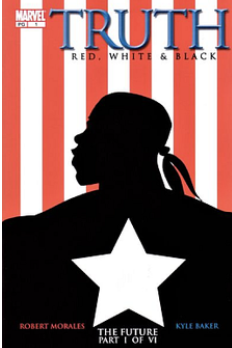Marvel Tackles Real World Issues Such as Grief, Trauma, and Racism in America in Disney+ Shows
June 10, 2021
*This article contains spoilers for the entirety of the MCU through The Falcon and the Winter Soldier*
Marvel Studios’ Disney+ shows have been huge hits. WandaVision and The Falcon and the Winter Soldier are some of the highest-rated Marvel projects to date, but they have ventured into topics that Marvel has been scared to address previously, such as grief, PTSD, trauma, and racism in America.
On the surface, WandaVision seems like a quirky sitcom, but towards the end of the nine-episode series, it becomes clear that this show is dealing with something much more real and much more serious. Wanda Maximoff, the main character of this show, has imprisoned herself in a perfect sit-com bubble inspired by her favorite shows growing up. She wants a world where she can live out her ideal suburban life with her dead love Vision and children of her own. By episode eight it becomes clear that the “hex” was a facade for Wanda’s grief, and looking back on the previous episodes with this new knowledge, one can see that Wanda experiences the five stages of grief over the course of this series. Episodes one and two are denial; Wanda and Vision are living a happy life, participating in classic sitcom situations, dinner with the boss, neighborhood talent show, etc. Then, episodes three and five start to move into anger. Episode four takes place outside the sit-com world where Wanda blasts Monica Rambeau (or “Geraldine”) out of the hex for mentioning her dead twin Pietro and then becomes violent towards SWORD and Director Hayward when they try to assassinate her (fair enough).
Episodes five and six deal with bargaining; Wanda finally gets something she wants, her twin back (by way of Agatha Harkeness’s manipulation, but that comes later), so she’s happy to fall back into that easy sit-com dream world until Vision tries to escape and she has to expand the “hex” to save him. Wanda’s dream world starts falling apart even more when she has a huge fight with Vision (more anger) about what she’s not telling him and gradually getting her trademark Sokovian accent back. Depression is possibly the easiest stage to identify in this series. Wanda becomes depressed in episode seven after her “reckless evening,” expanding the hex, and dealing with “Pietro’s” relentless questioning. She completely disregards her kids and stays in her pajamas all day watching TV. This is the last sit-com-inspired episode referencing The Office with the theme song and Modern Family with the mockumentary style of the overall episode. The last stage of grief, acceptance, is portrayed throughout the last two episodes. In episode eight, Wanda is fully out of the sit-com bubble, going on a tour of her past traumas by way of Agatha Harkness’s magical door. They explore how she got her powers, her life with her family before the accident that killed her parents, and even her and Vision’s first real moments of falling in love, shortly after her brother’s death. Here, Vision delivers the beautiful line, “what is grief if not love persevering?” and Wanda starts to heal.
Episode nine, the finale, is much more of a classic Marvel storyline with lots of action, but at the very end, we see Wanda fully accepting that she can’t have everything she wants, choosing to let go of Vision and her kids Billy and Tommy to save the hundreds of residents of Westview and dissolve the hex. This storyline is a beautiful portrayal of grief and a wonderful place to take the character of Wanda, because, after all, she has been through a lot.
Marvel Studios’ The Falcon and the Winter Soldier is similar to WandaVision in that the trailer made it seem like a classic buddy-cop action movie with lots of funny quips and banter. But the real thing is far from it, tackling race, identity, trauma, and therapy.
Similar to WandaVision, TFATWS explored mental health in a way that certainly surprised some fans, especially given the way the show was presented in the trailers. One of the first scenes we see of Bucky in this show is him waking up from a nightmare where he is the Winter Soldier again, showing that trauma is still present in his life. Everything we see regarding Bucky in the first episode of this show is him “making amends,” per the recommendation of his therapist. It’s important that this show helps to normalize therapy. I think therapy is something many people are embarrassed about or don’t want to admit to doing, but really it’s very good for you and helps many people.
Episode two of this show hits viewers over the head with the effects of racism in America. Sam and Bucky go visit Isaiah Bradley, a super-soldier from the Vietnam War. Isaiah was the only survivor of a series of fictional experiments done by the U.S. government on Black men. He overheard plans to bomb a camp holding hostages that were a part of the same program. Isaiah tells Sam that there was no way he was going to let his brothers die, so he escaped the facility he was being held in and saved their lives. For his heroic acts, he was thrown in jail for 30 years, experimented on because of the serum in his blood and treated horribly. The only way that Isaiah was able to escape these horrid conditions was to have a nurse declare him as dead. As he says, “they erased me, but they’ve been doin’ that for 500 years.”

His backstory differs from the comics to the show, but it’s important to know both. Isaiah was first introduced in the comic series Truth: Red, White, and Black, written by Robert Morales and penciled, inked, and colored by Kyle Baker. Published in 2003, this seven-issue limited series follows Isaiah Bradley, the only survivor of a program in the 1930s meant to use Black men as unwilling prototypes for the super-soldier serum that would eventually create Steve Rogers. The short of itis that Isaiah was being used by the U.S. government in ways he didn’t want to be, so he escaped and ran off to do something he believed in, ultimately saving hundreds of lives.
In the MCU, Isaiah’s wife died while he was in jail. She wrote him hundreds of letters but no one let them get to him, and he only ever saw them because the same nurse who declared him dead gave him the box with letters in it. At the end of the season, in episode six entitled “One world, one people,” Sam becomes Captain America and gets a section of the official Captain America exhibit at the Smithsonian dedicated to Isaiah, with a statue of him and a plaque explaining his story. Sam tells Isaiah “now they’ll never forget what you did for this country.” Causing the now old Isaiah to tear up and wrap Sam in a huge hug.
Isaiah’s story represents the difference in the way people are treated based on their skin color. Steve Rogers essentially did the exact same thing in World War Two. He escaped his military camp to rescue Bucky and the other soldiers imprisoned at the Hydra base, saved hundreds of lives, and is treated as a national hero, whereas Isaiah was thrown in jail. Their only real difference was, and Sam put it, his “blond hair and blue eyes.” It’s a powerful message to the audience especially in light of recent events regarding the treatment of Black people in America and the double standards they face.
In episode five of the series, Sam decides to become the next Captain America. Even though Isaiah Bradley warned him, “they will never let a black man be Captain America. They will erase you.” Sam talked it over with his sister and Bucky who both fully supported him. Sam conceded, “Isaiah has been to hell and back. If I was in his shoes, I’d probably feel the exact same way. But what would be the point of all the pain and sacrifice if I wasn’t willing to stand up and keep fighting?” This lets viewers know to not give up hope, as Sam represents a new hero and figure for generations to come both in the MCU and in the real world. In the show, we see a sweet scene of Sam’s little nephew tracing his finger along the star on Sam’s shield, and the actor who plays Sam, Anthony Mackie, has said in an interview that one of the coolest things about being Captain America is getting to see his sons and other black boys relate to a superhero who looks like them, and one who is actually a main character, not some side-kick.
Marvel Studios has really taken many steps towards making their characters more relatable to the masses while also incorporating important real-world issues and lessons to teach their ever-growing audience. I consider it incredibly brave of them to do this at such a vulnerable time in this franchise with the end of a saga in Avengers: Endgame and the start of a brand new Avengers team.







